People
‘It’s a Celebration of Art-Making’: Fresh Beauty Co-Founder Lev Glazman on Designing a Hotel in Hudson for Creatives
The Maker is now open in Hudson, New York
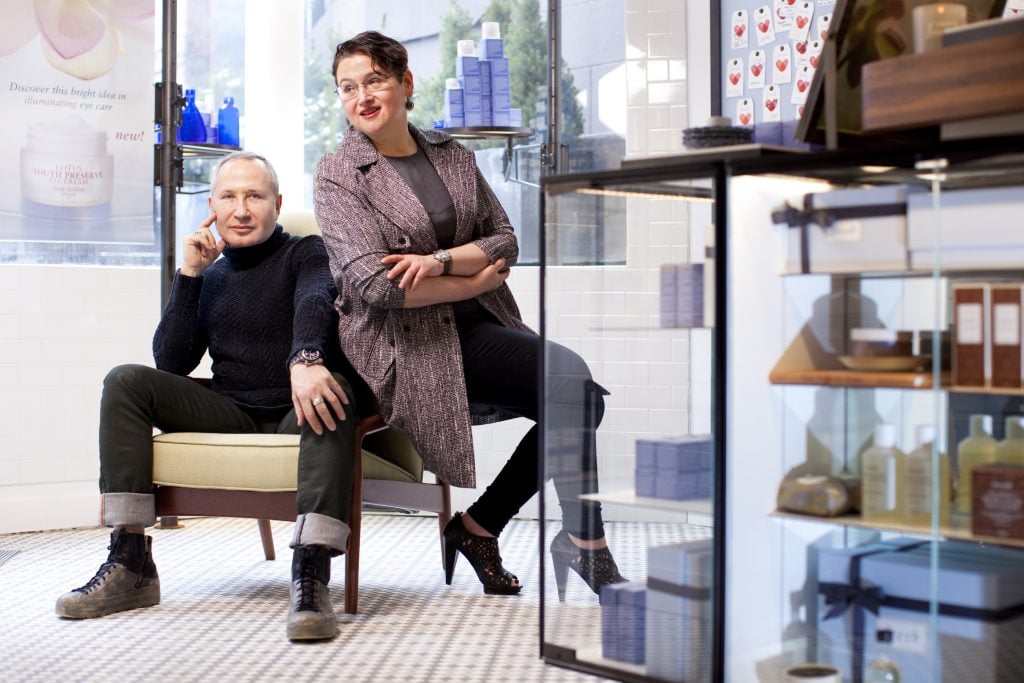
The Maker is now open in Hudson, New York

Noor Brara

In 1991, Fresh Beauty co-founders Lev Glazman and Alina Roytberg revolutionized the beauty industry by creating one of the first commercially successful companies to sell products composed entirely of natural ingredients. What’s more, the two, who were raised respectively in Russia and the Ukraine, eventually sold a majority stake of Fresh to luxury behemoth LVMH in a lucrative deal in 2000, turning their small Boston-based apothecary into a big name in the beauty business.
Known for their tried and true home-style remedies—they were among the first to use sugar as an exfoliant in their lip and body balms, for example—the duo has always been passionate about their business ventures, approaching each new project with a sense of artistry.
So it wasn’t so surprising when last year they opened the Maker, a boutique hotel in Hudson that was founded entirely as a respite for creative types. The property is divided up into a series of rooms and suites dedicated to fields in the arts—the Writer’s room, the Architect’s studio, the Artist’s suite. Since its opening, it has become a beloved space in Hudson for local creatives and visiting ones alike, and is home to an impressive collection of vintage design and artwork.
To discuss his love of art, how the hotel’s collection of art and design came to be, and how art should live in relation to the space it fills, we recently spoke to Glazman. Read on for the conversation.
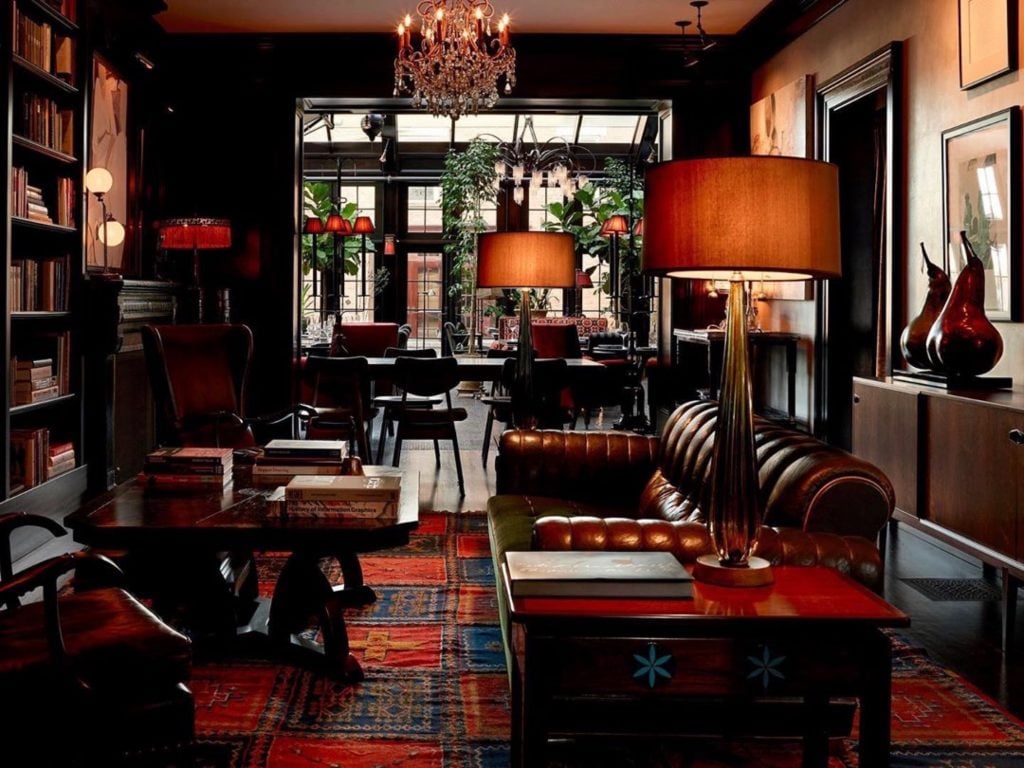
Photo courtesy The Maker.
Tell me a little about how why you decided to create the Maker, a hotel you envisioned for artists and other creative types in Hudson.
I think a lot of creatives in New York are looking for a place of respite to focus on their work and feel inspired. They seek a getaway, and to get here you only need to take a short train ride or drive up. Hudson really operates like a little city, but of course it’s a more rural environment, in the best ways. You have the Catskills, the river, the rest of Dutchess County to explore. And then in town you have this incredible street, Warren Street, which is probably one of the biggest antique centers on the East Coast.
There are also a lot of creatives that live here full-time, or mostly full-time—artisans, artists, interior designers, writers. It’s a very diverse community, which I love. So the Maker kind of bridges the creative communities in New York and Hudson in that sense. They gather together here. But also, bringing in something like this does make a difference to the local community because of how we engage with people living here on a day-to-day basis and since day one. We’ve collaborated with a lot of local artists and artisans to restore everything in the property… the building is from 1897. It’s a Georgian-style home. We upcycle everything, we reuse as much as we can. We stripped everything and put it all back together. Everything has been done with a lot of intent, a lot of artistry, and respect for where we are.
How long did it take to restore the building?
It took us about three years from beginning to end. There’s a lot of structural work that had to be done, from the floors down. The building committee considers the property to be Greek revival, but funnily enough the only true Greek revival part of it is the entry. But I suppose they had to identify it as such. The courtyard is lined with Hudson Valley Bricks. Parts had to be reconstructed and we wanted to keep the original design and intent of the structure, so we looked all over the East Coast to make sure we found the right ones from the same period to maintain the visual effect and integrity.
The lounge was an interesting project, too. Initially we wanted it to be a gym and then a bar. But when we stripped it, we realized it made the most sense as a lounge. In the bar, there’s a fireplace, which became the center of my design inspiration in many ways, for much of the property. We were working with someone from an amazing furniture shop to fill the room—he used to work at Sotheby’s. He restores really precious furniture. A lot of the elements from the fireplace he had to carve by hand because we wanted to raise the height.
I know color theory informed a lot of your decisions in terms of how you brought the property’s overall design to life. Can you tell me a little about that?
We have what we call Maker green, which is sort of where it all started. And we worked with local artists and designers to build out the color environment from there—I’m obsessed with lighting, for example, and so I worked with a local lighting artist named Stephen McKay to do the vintage lights and lamps everywhere. We have almost 1,000 lamps on the property. Some things we design ourselves and others are sourced vintage and it comes together to create our built environment.
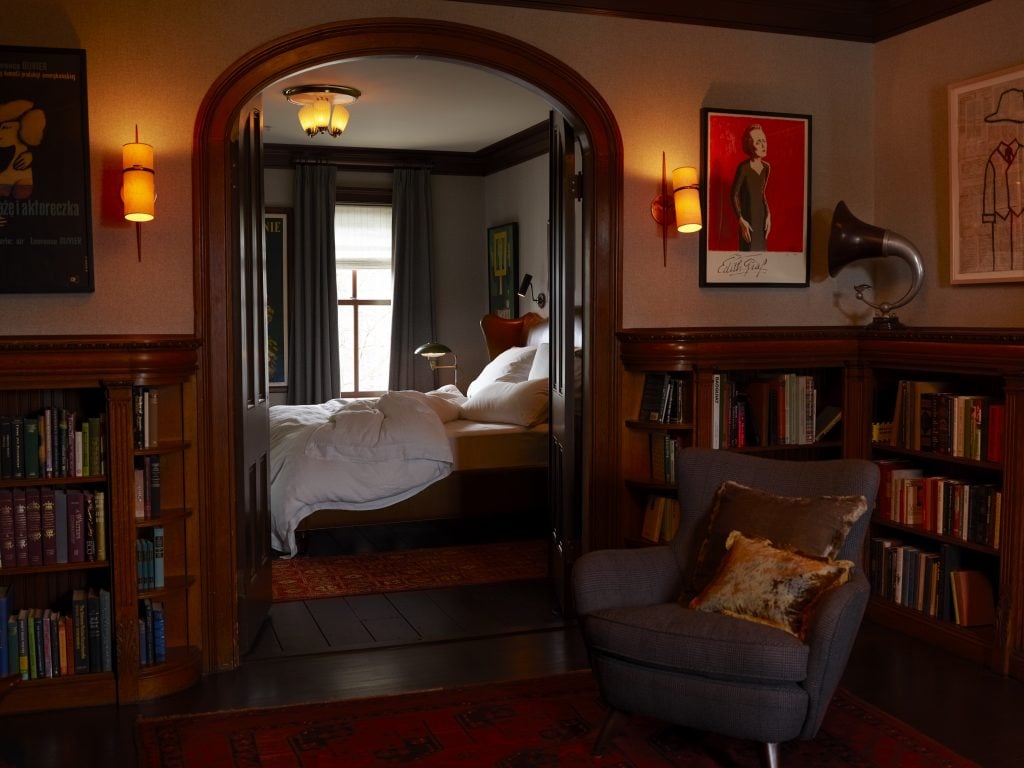
Photo courtesy The Maker.
Why is green your base color?
Green is a color of promise. Obviously it conjures chlorophyll, which gives plants life. And here, it’s more connected to the idea of renewal and revival, and kind of acts as a prompt to look at life through a much more expansive lens. It encourages a certain artistry. Our green is particular… it’s a little more of a teal green, it has black and blue undertones. But green, the orange, they all represent expressions of creativity. So we started populating the property with artwork after the design and color theory were worked out. We feel it inspires the kinds of people who come here, many of them who do creative work.
Can you tell me how you went about acquiring the artwork? Where do you source it and what kind of work were you looking for?
I appreciate all kinds of art. It’s less about authorship than about what talks to me, and how that can exist in my spaces, whether it’s for my home or here at the Maker. In some cases, I don’t really know a lot about the artists, either. I’ve bought a lot of work at the Serpette flea market in Paris, for example. I remember this guy was selling a painting that was ripped in the middle, so we had it restored. He didn’t know who made it. So I don’t know who it’s by. But it’s one of my favorite pieces. It’s definitely a Spanish artist, but that’s pretty much all we know… I curate a lot of the art here with my daughter, who is an art major. It’s important for us to have art in all the rooms and the ability for people to engage with art in every space. It isn’t about the price—we don’t have $100,000 paintings here—but it’s really about a celebration of art-making, which is ultimately what we stand for, and being intentionally eclectic.
That said, we have works in our collection by Pablo Picasso, Alberto Giacometti, Henri Matisse, Stanley Bate, Francisco Zuniga—a brilliant Mexican artist whose limited-edition prints we also sell at our shop, and they populate a lot of the space in our Artist’s Studio suite—Robert Flynt, Cecil Beaton, Agnes Martin, Jorge Castillo, Frantz Charlet, Luis Montoya and Leslie Ortiz, and April Gornick. We have a bohemian sensibility and I like to celebrate eclecticism in a big way.
And what influences specifically have factored into the design, which complements the art?
I’ve worked to unite mainly three design periods: the Belle Epoque, and its refinement, its lines, its sensuality; Art Deco, because of the architecture; and mid-century modern because that period was the beginning of kind of the furniture that feels current today, but there were so many feats of engineering in that as well, because it was really about functionality and a certain comfort, a correction of proportions. I like 1800s industrial as well, and how that period treated materials like metal and wood. So when I was looking and imagining the design for the property, those were kind of my guiding principles. I’m not a minimalist, I’m a maximalist… with my emotions, with my creative side. It’s not that I like to be surrounded with things per se, but I like to be surrounded with stories. I want to create a place that feels like it’s been here a while, not that it has randomly appeared. Everything has to live in harmony.
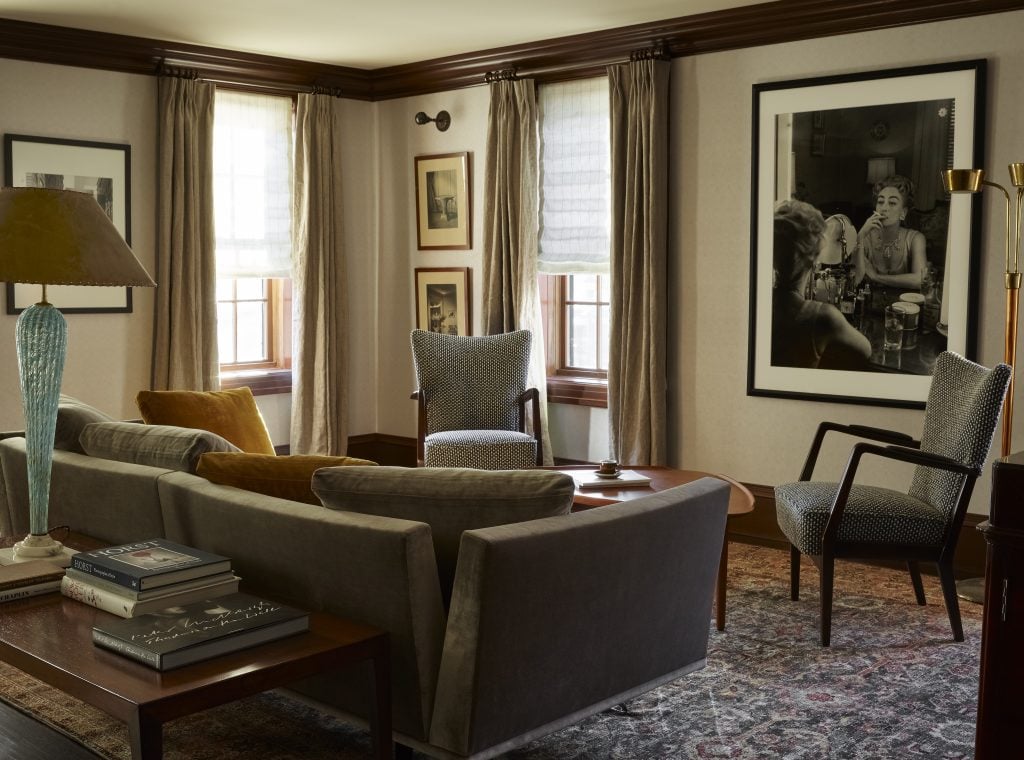
Photo courtesy the Maker.
It seems like every space, too, has grown from one object or one piece of artwork, one inspiration.
Yeah. That’s in part why it took so long to finish, too. I mean in the library for example, I began with one couch. I was like, “I’ve found the perfect couch, this couch is incredible.” Then I said, “Now we can start designing.” So we designed the whole room around the couch. Then we brought the couch back in in. And immediately, I had a physical reaction to it. I was like, “Take it out of here!” Because the space was rejecting it. The big part of any design… it can’t be learned or planned too much I don’t think. Candidly, I never really did interior decorating outside of my own home. But I let my instincts guide me, and I feel like a space tells you what it ought to be. And for this, the couch didn’t work because it was so overwhelming and nothing should do that. Everything needs to have an equal sense of cohesiveness. One thing has to be in conversation with another.
Without overpowering it.
Yeah. And that applies equally to the art we acquire and to the design. We curated pieces together so when you look at it, you intuitively understand what’s on the wall together and why.
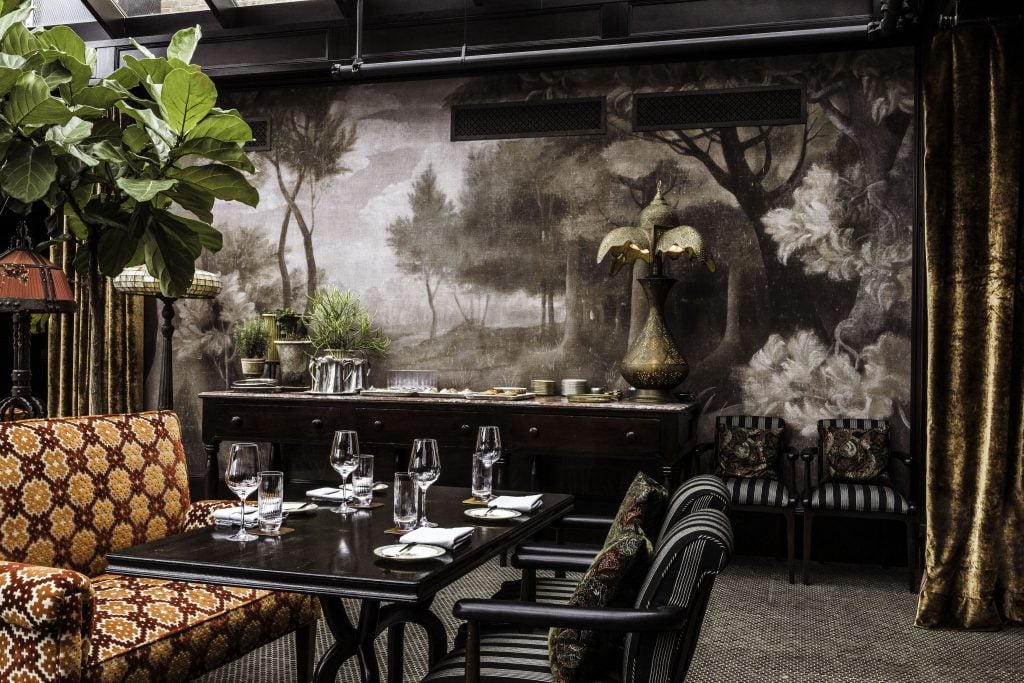
Photo courtesy the Maker.
I’m curious—what did the local community say when you first announced that you’d be doing this? You’ve been express in your intent to blend in with Hudson’s artist community, but people aren’t always the most receptive to new things coming in, especially from people associated to a big beauty brand like Fresh.
The idea of the Maker was that it’s for everybody, so we wanted to create a lot of public space for the local community to come together, like at the cafe or the gym or the juice bar. So we want locals to use the property as much as they can, and over 60 percent of all our furnishings were bought here, too. We really care about how, economically and socially, we are impacting the community. Some people of course felt reticent when we first moved in, but I would say the majority of locals love it. This cafe is how they start their day. And they come back for lunch and for dinner. It’s become a part of their home.